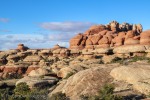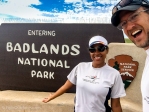
By Crystal Egli
Shortness of breath. Dizziness. Disorientation. Nausea. These are just 4 of the symptoms you can experience when getting high. No silly, I don’t mean smokin’ the reefer, I mean hiking at altitude! Jeeze, what’s on YOUR mind? Today I’m going to stray from the norm of introducing you to a new trail, and instead give you my top 4 suggestions on how to avoid altitude sickness, or even the start of symptoms at moderate elevations. Please note that I am not a medical professional, but my mom is, so that practically qualifies me to give medically related advice.

When this photo was taken I was feeling almost every symptom of altitude sickness one could experience…
Question From a Viewer: “What constitutes ‘high altitude’?”
Good question fake person, I’m glad you asked. If you live, work, sleep and exercise at sea level, you might start feeling a difference around 5,000′. You may not feel it just hanging out doing nothing, but take a 5 minute jog and you’ll see what I mean. The breaths come heavier almost immediately, and you start to wonder just how out of shape you are. No, it’s not you… it’s the altitude. If you live at 5,000′, like may folks in this great state of Colorado, it might take 10,000′ to make you feel something. For me, I just moved to CO and I’m am “Altitude Sensitive” (a non-clinical self diagnosis Andre refers to as “being a pansy”) so I start feeling altitude around 8-9,000′. (Um, that’s 8,000′-9,000′, not just 8 feet above sea level.) Everyone’s resting altitude and body makeup is different, so don’t feel bad if you’re huffing and puffing with the beginnings of a headache at 9,000′ when your hiking buddy is totally fine and has an active heartbeat of 67.
“I have another question; what are the symptoms of altitude sickness?”
Another great question from the fake person I made up. Symptoms can include but are not limited to: shortness of breath (like after walking 10 yards), headache, dizziness/lightheadedness, nausea, fatigue (again, more than normal for what you’re doing), and vomiting. If you’re climbing at extreme altitudes like Mt. Everest your symptoms will appear more severe, and you can expect shortness of breath, respiratory failure, cerebral edema, coma, and/or death. (Thank you WebMD!)
“So what are these 4 tips you keep going on about?”
Shut up fake person. I’m getting to it.

Stopping to take pictures of flowers is an excellent excuse to rest.
Altitude Tip #1: Hike slowly
This is probably the most boring advice I’ve ever given. Hiking slowly suuuuuucks. I mean, come on. We’re young! We’re athletic! We’ve got the youthful energy of people one year years younger! Woah, slow your roll homie. Seriously. You need to slow down to a stroll when you get up into the higher elevations. Over-exertion is the easiest way to make yourself feel real bad real quick, and you won’t even know you’ve done it until you are on the side of the trail tossing cookies. If you’re hiking several thousand feet higher than you normally live at, cut your pace in 1/2 by walking slowly, taking frequent rest stops, and taking time to enjoy the scenery. Trust me, the scenery looks much better this way than the view you’ll get sitting on a cold rock with your head between your knees.

Look Mom! I’m hydrating!
Altitude Tip #2: Drink lots of water
You’ve undoubtedly heard this one before but hear me out, because I mention pee in a second. You should already be in the habit of drinking water while hiking, but drink MORE at altitude. Take frequent sips while on the move, and don’t be afraid to hydrate during those luxurious rests you’ll be taking, after heeding my advice in Tip #1. Many people are worried that drinking too much water will make them have to stop and pee. This isn’t so much of a problem for our dude readers, but women suffer from a higher rate of dehydration on the trails because peeing outdoors for us is suuuuper annoying and we generally avoid it at all costs. But there’s good news! When you exercise heavily your kidneys kinda shut down a bit and you don’t have to pee as often as you usually do. So drink up!
Altitude Tip #3: Take Ibuprofen
I learned this one from a friend and confirmed it on the internet, so you know it’s trustworthy advice. My friend suggests taking 3 Ibuprofen about 2 hours before you hit the trailhead, and if you’re going 13,000′ or higher to take 3 more at the summit. Remember that time I said I wasn’t a doctor and I’m not qualified to give medical advice? Yeah, that. The internet says the anti-inflammatory properties makes it easier for your blood to flow around and give itself oxygen. I’ll try it on one of our next high altitude adventures and I’ll let you know if it works in an update.

Andre still thinks Mountain Dew is water.
Altitude Tip #4: Watch what you eat and drink
Avoiding caffeine and alcohol on hike-day will definitely help. I’ve forgotten this one a couple times and had a few cups of coffee on the drive to the trailhead, and let me tell you– my heart rate was all jittery and it was not as pleasant as it could have been. Leave the java and the flask at home on your high altitude treks. On the flip side, I’ve heard and read that upping your potassium intake can be beneficial. These are foods like bananas, dark chocolate (add to trail mix!), cantaloupe, apricots, oranges, eggnog, almonds, canned pumpkin and lentils. Some of these are easier to bring on the trail than others, but I for one will never leave home without my eggnog-lentil soup. But if that’s not wetting your appetite, here’s a list of other high potassium foods.
All right, so there’s my top 4 suggestions for avoiding altitude sickness. If you have more I’d love to hear them! Please let everyone know you’re smarter than me by adding your tips in the comments section below. Now let’s go climb some 14-er’s! (Who’s bringing the canned pumpkin?)
– C. Egli



I know one! Avoid fatty foods like sausages and things cooked with olive oil before and during the hike. Your body can’t proceed fats the same way at altitude, and you’ll want to avoid needing to do more than pee on the side of the trail. Trust me on this.
LikeLike
Great tip! Haven’t heard that before but it makes total sense. Thank you so much for sharing.
LikeLike